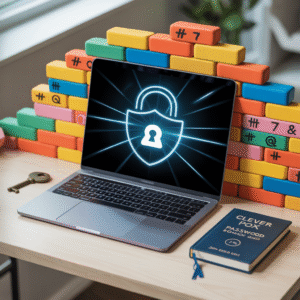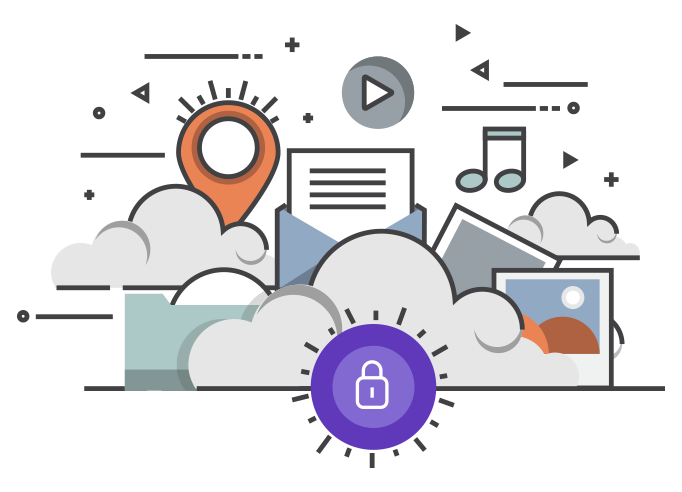💡 DIY Computer Fixes?
Grab my easy step-by-step guide and keep your computer running like new.
How to Create Safe Passwords Without Remembering Them All
If you’re like most people, you probably have more passwords than you can count.

The good news is that you can create safe passwords without memorizing a million of them, and it’s much easier than it sounds.
And because it’s impossible to remember them all, many people end up doing something risky: reusing the same password everywhere or using simple ones that are easy to guess.
It might feel harmless, but it’s actually one of the most common ways hackers break into accounts. The good news is that you can create safe passwords without memorizing a million of them, and it’s much easier than it sounds.
Let’s walk through a simple plan to keep your online accounts safe while keeping your stress low.
🧠 Why Passwords Matter More Than Ever
Passwords are the first line of defense between your private information and the entire internet.
Unfortunately, cybercriminals have powerful tools that can guess weak passwords in seconds. If one site gets hacked and your email and password are leaked, criminals will try using that same combination to break into your other accounts — a tactic called credential stuffing.
Consider this:
If you reuse a password on 10 sites, and one gets hacked, you’ve put all 10 at risk.
If you use a weak password (like your pet’s name), attackers can often guess it using social media clues.
That’s why strong, unique passwords are essential — especially for your most sensitive accounts like email, banking, and shopping sites where your credit card is stored.
💡 What Makes a Strong Password?
A strong password should be:
At least 12 characters long (longer is even better)
Includes uppercase and lowercase letters
Contains numbers and special characters like
! @ # $ % ^ & *Completely random and unrelated to personal info
Example of a weak password:Buddy123 (too short, predictable, and tied to personal info)
Example of a strong password:T7$sun!42hQw (long, random, hard to guess)
Strong passwords are harder to remember — and that’s actually the point. The harder they are to remember, the harder they are to guess.
But don’t worry… you won’t need to memorize them all.
📓 Step 1: Store Passwords Safely in a Password Book
Believe it or not, writing passwords down can be perfectly safe if you do it the right way.
Digital hackers can’t break into paper. If you’re not comfortable using digital password managers, a good old-fashioned password book is a simple and secure solution — especially for home users who don’t share their computer.
One of the best options is the Clever Fox Password Book 2nd Edition Small. It’s small enough to keep tucked away safely, and it’s designed specifically for organizing passwords alphabetically.
Just be sure to:
Keep it somewhere safe (not taped to your monitor!)
Never take it out of the house
Update it when you change passwords
This is especially helpful for seniors or anyone who prefers pen and paper over tech tools. It keeps your passwords secure and your mind at ease.
💻 Step 2: Use a Password Manager App (Optional but Powerful)
If you’re comfortable with technology, a password manager can save you tons of time and effort.
A password manager is an app that securely stores all your passwords and fills them in for you automatically. You only need to remember one master password, and the app does the rest.
Popular options include:
1Password – Known for its user-friendly design and strong security.
Bitwarden – An excellent free, open-source choice.
LastPass – A well-known option with both free and premium plans.
These apps can:
Generate super-strong passwords for you
Sync across your devices
Autofill passwords when you log in
Using a password manager means you can have unique passwords for every account without remembering any of them. If you have more than 20 accounts, this is a huge time-saver and security booster.
Popular options include:
🧩 Step 3: Use Passphrases for Important Accounts
Another trick is to use passphrases instead of traditional passwords.
A passphrase is a long string of random words that are easy for you to remember but hard for hackers to guess.
Example:GreenHorseCarpet!Fence77
It’s long, memorable, and includes symbols and numbers. Passphrases are especially good for important accounts like your email or your main computer login.
To make a secure passphrase:
Pick 4–5 random words
Capitalize a few letters
Add numbers or symbols in between
It’s much easier to remember “Blue!River8Guitar$Tree” than “t$7Fr%pQw1!r”.
⚡ Step 4: Turn On Two-Factor Authentication
Even the strongest password isn’t perfect. That’s why you should enable two-factor authentication (2FA) whenever a site offers it.
2FA adds an extra step to logging in. After entering your password, you also confirm your identity using something like:
A code sent to your phone
A code from an authenticator app
A physical security key
This means that even if someone steals your password, they still can’t get in.
Turn on 2FA on all accounts that support it — especially email, banking, shopping, and social media.
🧹 Step 5: Clean Up Old Accounts
We all have old accounts we no longer use — old email addresses, forums, shopping sites, or apps we’ve forgotten about.
These are a security risk if they still have weak passwords or contain personal info. Spend some time deleting or deactivating any accounts you no longer need.
This reduces the number of passwords you need to manage and limits the damage if one of those old sites gets hacked.
💛 Step 6: Create a Password Routine
Staying secure is much easier when you build it into your routine. Try this:
Check your password list every few months
Update old or weak passwords when you find them
Write down new passwords immediately in your book or password manager
You don’t need to change your passwords constantly — that’s an old myth. Instead, focus on making them strong and keeping them organized.
📌 Quick Safety Tips to Remember
Here’s a handy cheat sheet:
✅ Use a unique password for every account
✅ Make each password at least 12 characters
✅ Mix letters, numbers, and symbols
✅ Never share your passwords by email or text
✅ Don’t reuse passwords — especially on banking or email
✅ Turn on two-factor authentication everywhere possible
✅ Keep your password book or master password private
🧘♀️ Why This Matters for Your Peace of Mind
Strong passwords aren’t just about keeping hackers out — they’re about keeping your life stress-free.
Getting locked out of an account is frustrating. Dealing with a hacked account is even worse. The time and energy it takes to fix the damage can be enormous.
By taking a little time now to create strong passwords and organize them, you’ll save yourself a lot of worry later.
🖥 Need Help Getting Organized?
If this all sounds like a lot, you’re not alone. Many of my clients tell me they’ve been nervous about cleaning up their passwords for years — but once we do it together, they feel so relieved.
If you’d like help getting your passwords under control or just need your computer running faster and safer, I’m here to help.
I offer friendly, affordable computer help online to anyone in the U.S.
💻 Flat-rate $69.99 (seniors pay just $59.99)
💛 No charge if I can’t fix the problem
Your security matters — and it doesn’t have to be stressful.
📣 Final Thoughts
Creating strong passwords doesn’t mean you have to remember a million of them.
By combining smart tools like a password book or password manager with good habits and two-factor authentication, you can protect your accounts without overwhelming yourself.
You deserve peace of mind online — and it’s easier than you think.
So grab your password book, make your passwords stronger, and give yourself the gift of worry-free browsing.


